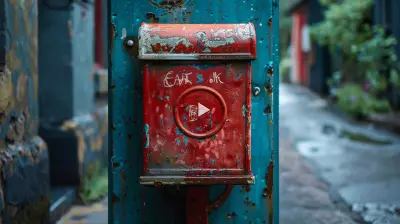Developing Strong Employee Recognition Programs that Work
23 May 2025
Picture this: You’re running a business, your employees are working hard, and you’re hitting some pretty impressive milestones. But there’s something missing—a little spark, an energy boost, a pep in everyone’s step. What’s the secret ingredient? Recognition. Yep, it’s that simple. Humans love to feel seen and appreciated. And in the workplace, a strong employee recognition program can be the magic sauce that keeps motivation high and turnover low.
In this article, we're going to dive headfirst into developing strong employee recognition programs that actually work. Not the cookie-cutter, "Employee of the Month" plaque that gathers dust in the corner—no, we’re talking about systems that feel personal, meaningful, and impactful. Let’s get into it. 
Why Recognition Matters More Than You Think
First off, let’s address the "why." Why should you care about employee recognition? Isn’t a paycheck enough? Spoiler alert: It’s not.Think of it this way—if your work is never noticed, it’s like shouting into the void. You’re putting effort in, but there’s no echo, no response. People need that response. Recognition satisfies a basic human need for validation and belonging. When employees feel appreciated, they’re happier. Happy employees? They’re more engaged, productive, and loyal to your business.
The Stats Don’t Lie
If you're a numbers person, here's some food for thought. According to a Gallup study, employees who feel recognized are 4.6 times more likely to perform their best work. And companies that prioritize recognition have 31% lower voluntary turnover.So, yeah, this stuff matters—a lot. 
The Building Blocks of a Strong Employee Recognition Program
Not all recognition programs are created equal. The ones that truly work have a few key characteristics in common. Let’s break it down:1. Timeliness is Everything
Imagine finishing a marathon, and someone congratulates you six months later. Feels kinda meh, right? The same goes for recognition in the workplace. Don’t wait until quarterly reviews to acknowledge someone's great work. Strike while the iron is hot. Did they nail that client presentation? Offer praise the same day.Timely recognition reinforces the behavior you want to see more of. It’s a quick, simple way to let your team know you’re paying attention.
2. Get Specific
Generic recognition is like a Hallmark card—you’ve seen it a million times. “Great job!” or “Keep it up!” doesn’t cut it. Instead, be specific. Highlight exactly what the employee did and why it was impactful.For instance: “Sarah, the report you put together for the Smith project was outstanding! The attention to detail and creative approach really impressed the client, helping us secure their business.”
See the difference? You’re not just saying thanks; you’re showing them you genuinely noticed their hard work.
3. Make It Personal
Not everyone wants a public shoutout in a team meeting. Some people would prefer a handwritten note, while others might love a spotlight moment. Know your employees. Tailor the recognition to suit their preferences—it makes the gesture feel authentic and thoughtful.4. Celebrate Big Wins and Small Victories
Recognition shouldn’t be reserved for only the monumental achievements. Sure, landing a million-dollar deal deserves some confetti, but don’t overlook the everyday efforts. A simple “You’re doing an amazing job managing your workload lately—I know it hasn’t been easy!” can work wonders for morale.
Common Types of Recognition Programs
When it comes to employee recognition programs, one size doesn’t fit all. Let’s go over some popular approaches, so you can find what blends well with your company culture.1. Peer-to-Peer Recognition
Top-down recognition is great, but don’t underestimate the power of peer-to-peer shoutouts. Sometimes, your colleagues see things managers might miss.You could set up an online platform where team members can send kudos to one another, or create a dedicated Slack channel for sharing appreciation. This builds a culture of mutual respect and camaraderie.
2. Monetary Rewards
Who doesn’t love a bonus? While money isn’t the only form of recognition, it sure doesn’t hurt. Consider offering performance bonuses, gift cards, or even extra PTO for a job well done.3. Public Acknowledgment
Whether it’s a team meeting, company newsletter, or social media post, public recognition shines a spotlight on achievements. Just make sure the recipient is comfortable being in the public eye—some might prefer more low-key praise.4. Long-Term Incentives
Loyalty deserves recognition too. Milestone anniversaries (like 5 or 10 years with the company) are perfect opportunities to show gratitude. Custom gifts, plaques, or even celebratory lunches can go a long way in making long-term employees feel valued.
How to Successfully Roll Out a Recognition Program
So you’re sold on the idea of building a recognition program. Great! But hold up—before you jump in, let’s walk through a few important steps to make sure it’s set up for success.1. Know Your Team
This is huge. Take the time to understand what motivates your employees and how they like to be appreciated. Maybe conduct an anonymous survey to gather feedback. Do they prefer private praise? Group celebrations? Monetary rewards? This intel will shape your program.2. Communicate the Plan
Transparency is key. When you launch the recognition program, explain to your team why you’re doing it, how it works, and what kind of behaviors you’re rewarding. Clarity will keep everyone on the same page.3. Be Consistent
A recognition program isn’t a "set it and forget it" deal. Make sure it’s implemented consistently across all teams, departments, and managers. Sporadic recognition can actually have the opposite effect—it can make employees feel overlooked.4. Measure and Adjust
Like any business strategy, you’ll need to monitor the program’s effectiveness and tweak it as needed. Use employee surveys or one-on-ones to gather feedback and make improvements over time.Potential Pitfalls to Avoid
Even the best intentions can lead to missteps. Here are a few things to watch out for:- Favoritism: Recognition programs lose credibility if employees feel only a select few are being acknowledged. Spread the love evenly.
- Overcomplicating the Process: If your recognition program feels like jumping through hoops, people won’t participate. Keep it simple and straightforward.
- Neglecting Feedback: Don’t assume your program is perfect once it’s up and running. Stay open to suggestions and make changes when necessary.
Real-Life Examples of Recognition Programs Done Right
Let’s take inspiration from companies that are knocking it out of the park:1. Google
Google’s peer-to-peer recognition program, known as “gThanks,” allows employees to send digital thank-you notes, which are sometimes accompanied by monetary rewards. It’s fun, easy, and a hit with employees.2. Zappos
Zappos takes recognition seriously with its “Zollar” program. Employees earn Zollars (company currency) for going above and beyond, which can be redeemed for branded merchandise or prizes.3. LinkedIn
LinkedIn celebrates work anniversaries using a mix of digital and in-person recognition. They even send personalized gifts to employees on milestone anniversaries—a thoughtful touch that fosters loyalty.Wrapping It All Up
At the end of the day, employee recognition is about one thing: making people feel valued. When you build a program that’s timely, meaningful, and tailored, you’re not just boosting morale—you’re cultivating a culture of appreciation. And a workplace that values its people? That’s a workplace that thrives.So, take the time to invest in a strong employee recognition program. Because when your employees feel seen, they’ll move mountains for you.
all images in this post were generated using AI tools
Category:
Human ResourcesAuthor:

Rosa Gilbert
Discussion
rate this article
3 comments
Ivan McGill
Intriguing insights! Employee recognition is crucial for fostering engagement and retention. I’m curious about the innovative strategies companies are using and how they measure the impact of these programs. Looking forward to learning more from your experiences!
June 7, 2025 at 4:39 AM

Rosa Gilbert
Thank you for your interest! Companies are increasingly using personalized recognition, peer-to-peer programs, and technology platforms to engage employees. Measuring impact often involves tracking employee satisfaction and retention metrics post-implementation. I look forward to sharing more insights!
Gisela McQuillen
Great article! Recognizing employees is key—just don’t hand them trophies for coffee breaks!
May 31, 2025 at 4:58 AM

Rosa Gilbert
Thank you! I completely agree—meaningful recognition is essential, and it’s important to focus on genuine appreciation rather than superficial rewards.
Avery Baxter
Effective employee recognition programs boost morale, enhance productivity, and foster a positive workplace culture.
May 23, 2025 at 3:09 AM

Rosa Gilbert
Absolutely! Effective recognition programs are key to creating an engaged workforce and a thriving organizational culture. Thank you for highlighting their importance!



